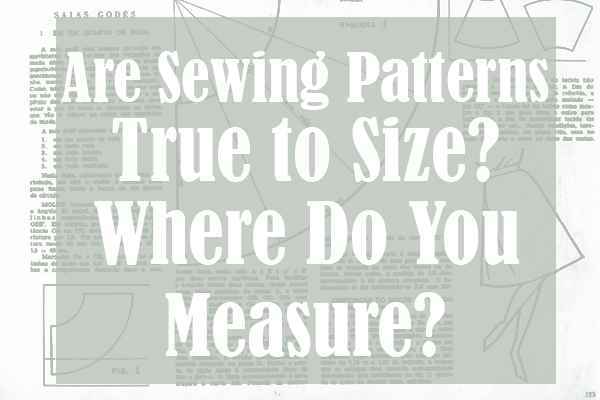
Are Sewing Patterns True to Size? Where Do You Measure?
The short answer is — no, sewing patterns are not true to size. You must have gone out shopping a few times knowing what your size was. But when you tried two T-shirts marked with the same size, one fit better than the other.
The truth is, not everyone is the same. Besides, people come in various shapes and sizes, which means the standards (S, M, L) do not always fit one’s individual size. All the more confusing is the fact that there is no agreed-upon standard for clothes manufacturers to follow. Also, bear in mind that pattern sizes go with the times.
Relying on ready-to-wear pattern sizes can be confusing for tailors. Therefore, our first step is to compare them to sewing pattern sizes to see what the catch is.
Sewing Pattern Sizes VS Ready-To-Wear Sizes

Most tailors will agree that fit is more important than quality. This means that even the best piece of clothing you have will look terrible if it doesn’t fit you well. On the other hand, you can easily diminish the flawed design of your garment by making it a good fit.
First, you should forget about your ready-to-wear size, because its measurements will differ from yours. Knowing you are a size 14 should not lead you to buy a size 14 pattern. As we briefly mentioned, ready-to-wear manufacturers do not follow a unified standard. However, Vogue and Butterick agree on their size standards, which may prove helpful.
What we found important is that it is all about measurement. Hence, you should always carefully measure your body beforehand, and now let’s see how this is done.
How to Take Body Measurements for Sewing Patterns

Always remember that the garments you are sewing are not the only thing you will be wearing. That being said, take your body measurements while wearing your usual undergarments. Hold your tape measure at each body point so it is snug but not too tight. That being said, here is how you should take your basic body measurements:
You should measure your height while you are barefoot, keeping an upright posture. If you are not sure whether your posture is right, stand against a wall.
As for the back-waist length, it should be measured from the prominent bone at the base of your neck to your natural waistline.
Your chest line is found high up under your arms and across the back and chest.
As for your full bust, measure it around the fullest part of your bust and straight across your back.
The waist and hips should be measured around the body, at your natural waistline and the fullest part of hips respectively.
How to Choose the Right Sewing Pattern Size
Now that you have taken and recorded your body measurements, it is time for you to find the right sewing pattern size. As we previously touched upon Vogue and Butterick patterns and their agreement on size standards, let’s look at an example chart:

Always pay attention to the chest and bust. For example, 32 around the chest and 34 around the bust means you would want size 12 for this top. Another thing you should consider is the size of your hips, as it is a lot easier to fix than the bust size.
Sewing Patterns Between Sizes
What makes people want to sew their own clothes is the fact that their hips, waist, and bust measures correspond to different sizes on the chart. For example, it is almost never easy to find clothes that fit a smaller bust, but a larger hip.
With that said, let us take a second look at the table above. Let us say your hips are 38˝. This means you could add 2˝ to the hip measurement for size 12.
Now, let us say you wanted to make a skirt, for example, a Butterick 5466. Your hip measurement is what you should consider first. If 40˝ is the case, you will look for the size 16 skirt. On the other hand, if your waist is 28˝, decrease the waist on the pattern by 2˝.
The style of the garments may also allow you to disregard certain measures. For example, when sewing Butterick 5357, you can only focus on the bust and hip measurements.
Do Pattern Sizes Run Small?

We hope you remembered that size standards between manufacturers vary. Off-the-rack clothing has standards for what the manufacturer calls a certain size. Hence, one may wear a 12 in one brand and a 16 in another, whereas in patterns, it can be a 22.
The short answer is — no, they do not run small. In fact, some have even argued that patterns run large. This is mostly because manufacturers have to account for ease, which is the extra room that allows your body to move.
If you want to avoid having to exchange patterns you bought from a manufacturer, always look at the measurements on the back of the envelope. Next, you should compare these against your body measurements and stop relying on what your clothing labels say. As we have seen so far, standard sizes are not so standard after all.
Final Thoughts
Even though sewing patterns are not true to size, this does not mean you should give up sewing altogether. In fact, we hope we have given the advice needed to make your experience less frustrating. Remember, measurements are the key criterion when searching for the right pattern sizes.
Finally, we recommend you to join Reddit. There is a massive community there called r/sewing, where you can discuss all things sewing with other users.
Please, share this article and tell us if you had any mishaps with pattern sizes below (and how you solved them).

